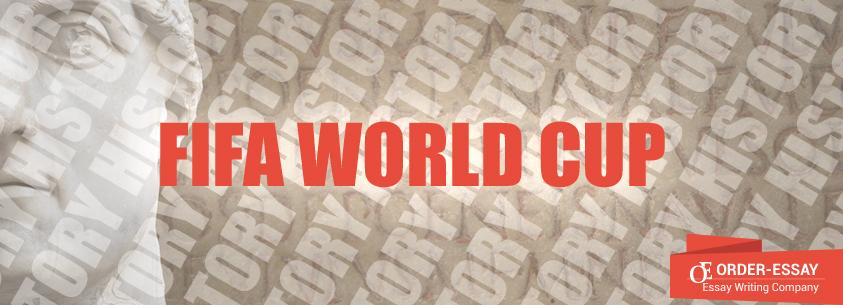
Introduction
May 29, 1928, the next FIFA Congress made a historic decision – the majority of its members voted for the establishment of the World Cup. In a year, the next FIFA Congress elected Uruguay as a country, where the first Cup would be held. Since that time, the national soccer teams of all countries that are members of FIFA have been allowed to participate in the World Cup. Both male and female teams can take part in the tournament. The final game of the championship takes place once every four years. At the same time, the total duration of the tournament along with the qualifying matches is three years. FIFA World Cup is the most important and exciting event in the world of soccer. The paper will discuss the history of the World Cup as well as the rules of the tournament.
History of Soccer
Soccer is one of the most popular team sports around the world. “It is the national sport of almost every country on earth except the United States, Australia and South Asia” (Orejan 5). History of this sport extends back a lot of centuries. “In reality, there was no first game of football, for its origins go back to the beginning of the recorded history” (Murray and Murray 2). Games that vaguely resembled soccer were known among different peoples in ancient times. Mention of them can be found in the written sources of ancient China and Japan. Images of soccer stories were found in the tombs of Egyptian pharaohs. Similar games were not only the means of entertainment or physical training of soldiers. Historians note the pagan foundation of ancient soccer, where the ball symbolized the sun. Due to the Roman conquerors, the ball game was known on the British Isles. The game quickly received popularity among the indigenous inhabitants. Around the fifth century, this game disappeared with the Roman Empire. However, the memory of it remained in the Europeans. Even Leonardo da Vinci played soccer with Florentine boys. When in the 17th century, supporters of King Charles I ran to Italy, they became acquainted with the game there. In 1660, after the accession to the throne, Charles II brought it to England, where soccer became the game of courtiers. It was in England that soccer became very popular.
Modern soccer began its journey in the XII century in medieval England. Then, people played soccer in market places and even in narrow streets. They played it from morning till evening. The number of players then exceeded 100, and almost no restrictions existed. People could play using hands and feet. Over time, the game began to get civilized. Some teachers expressed the thought of its exceptional physical benefits for the development of young people. At the beginning of 19th century, soccer was cultivated in privileged schools in England. It changed not only the attitude to the game, but the game itself. “Outside of Great Britain in the late 19th century, soccer as an organized game began to be developed in countries around the world, taken to places as diverse as Argentina and Austria” (Dunmore 6).
History of the FIFA World Cup
May 21, 1904 went down in history as the day of the creation of FIFA. At that time, six countries: Spain, Netherlands, Belgium, Sweden, France and Switzerland were the participants of the Football Federation. Already in one of the first meetings, the delegate of Holland introduced a draft on the organization of the World Cup. However, he did not have much support in view of the modest financial possibilities of the new federation. The first international soccer competitions started in the early 20th century, namely in 1908, when the amateur soccer became part of the Olympic program. A year later, Thomas Lipton organized a soccer tournament. Its name was “The very first soccer World Cup”. Teams of Switzerland, Italy and Germany became the first participants of the tournament. English players were at the origin of soccer. However, this team refused to take part in the tournament. Realizing that without the British team, this championship could not be considered serious, Sir Lipton invited the team from the north-east of England to take part in the Cup. Despite the fact that most members of the English team were workers of coal mines and only a few of them were professional soccer players from the continent, Englishmen won the tournament (Dubois 30). At that time, the Olympic soccer was the only official competition, in which players from different countries could take part. However, seeing the profound difference in class between the professional and amateur players, the FIFA team decided to organize the World Cup. “The FIFA Congress in Amsterdam decided that the World Cup was to be disputed every four years starting in 1930” (Almeida 1).
“Four European nations applied to host the tournament, but the honor fell to Uruguay” (Colley 3). Two wins of the national team at the Olympic Games and the firm promise of the representative of Uruguay to meet all the financial terms of FIFA were talking in favor of this choice. Parisian jeweler Abel Lafleur was awarded the honor to create the first trophy – the FIFA Cup. The Gold Cup portrayed Greek goddess of victory Nike. The theft of the “Golden Goddess” caused a real sensation around the world. This incident took place in London. The Gold Cup was on public display in one of the halls of the Palace of Westminster, where the international philatelic exhibition was held. A week later, a plain mongrel dog called Pickles found the Cup. The dog spotted a bundle lying under a laurel bush in the garden of his owner David Corbett. In 1983, the Cup was stolen again from the building of the Brazilian Soccer Federation in Rio de Janeiro by two armed robbers. Its destiny remains unknown. Since that time, in the world championships, another Cup is played – the FIFA World Cup. It is made of gold by Italian jewelers. The cup is passed on from one team to another. The winners receive its accurate but most likely gilded copy.
The first football World Cup began July 13, 1930. Therefore, the history of the FIFA World Cup begins in 1930. The Uruguayan national team – the hosts of the tournament – became the champions of the first World Cup. “Every four years the world of soccer comes together for one of the greatest sporting events” (Kraba 17). During the almost 80-year-long history of the tournament, only 7 countries participants became the winners of the World Cup. It was Brazil that most often won the title “the world’s best soccer team”. This country has five victories on its account. Four times the Cup went to Italy and three times to Germany. Uruguay and Argentina became champions twice. Soccer teams of France and England won the tournament once each. As for the players, Pele became the world champion in soccer three times. About 20 players won the World Cup twice. Most of them are from Brazil.
Qualifying Competitions
Before the tournament, teams have qualifying competitions. They are held in order to reduce the number of participants and select the strongest teams for the final tournament. The only championship, before which, qualifying competitions were not conducted, was the very first championship in 1930. Qualifying competitions are held on a zonal basis, in accordance with the FIFA regions: Africa, Asia, South America, Oceania, Europe and North America. Regional federations (in Europe, for example, UEFA) are engaged in organization of qualifying competitions in accordance with the general principles of FIFA.
Before the next tournament, FIFA determines the number of places in the final tournament received by each region. The main criterion is the “strength” of soccer in the region. However, the fact that additional places in the World Cup final stimulate the development of soccer in the region is also taken into account. Since 1938, the country which organizes the tournament automatically gets a place in the final. Moreover, until 2002, the winner of the previous World Championship also received a place in the finals without preliminary selection. However, when the regulations of 2006 World Cup were determined, this rule was abolished. The 2002 World Champion Brazil participated in the qualifying tournament on standard terms. Nowadays, the qualifying tournament starts nearly three years before the final and lasts longer than two years. The format of the qualifying events is very different in different regions. It also varies from tournament to tournament. Typically, in addition to competitions within the region, there are several additional intercontinental play-offs, the winners of which go to the final (Andreff and Szymanski 198).
Final Tournament
Since 1998, a formula used to conduct the world championships ensures the presence of 32 participants in the final tournament. The final tournament takes place in a pre-selected country during a month. “Soccer for a single month can unite people of different languages and cultures” (Lisi 2). The final tournament consists of two stages: group tournament and elimination games of the cup system. At the stage of the group tournament, teams are divided into 8 groups of 4 teams. The composition of the groups is determined by draw, during which, 8 teams become first numbers in the group and the remaining 24 teams are divided into three “baskets” in accordance with their geography and rating. In the end, from each basket in each group, one team goes. However, there are additional rules that complicate the procedure of drawing. For example, in one group, there cannot be more than one team from any region or more than two European teams.
In each group, the team conducts three rounds of the tournament. To eliminate the possibility of collusion, matches of the last round are held on the same day and at one time. For the victory in the match, the team gets 3 points and for a draw, it gets one point. Two teams from each group, who took the first and second places, pass in the second round. There are 16 participants of the championship. In the second round, teams play elimination matches. Losers end their participation in the tournament. If the score after 90 minutes of a game is drawn, the extra time and if necessary, a series of penalties is given. In the 1/8 final a winner of each group of the first round plays with another team from the other group. Then, the winners go to 1/4 finals, semi-finals and finals (Richards 115).



The winners of the finals become world champions. They receive gold medals and the World Cup in temporary storage – until the next World Cup. The finalist team that loses is awarded small golden (or gilded) medals. Teams which lost in the semi-finals play for the third place in the match between themselves. The third team gets silver medals and the fourth – bronze. This system of awarding appeared in 1966 and exists today.
Get a Price Quote
Conclusion
Nowadays, soccer enjoys international recognition around the world. It is difficult to imagine life of any country without football matches. FIFA World Cup is the most profitable sporting event besides the Olympics. FIFA World Cup is the greatest contemporary sporting event. It collects millions of viewers all over the world.








